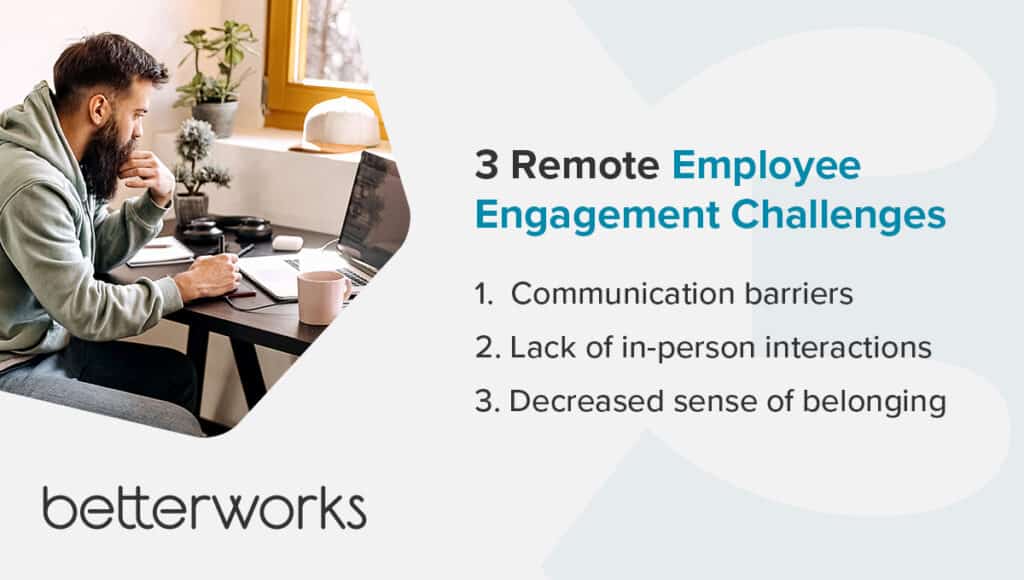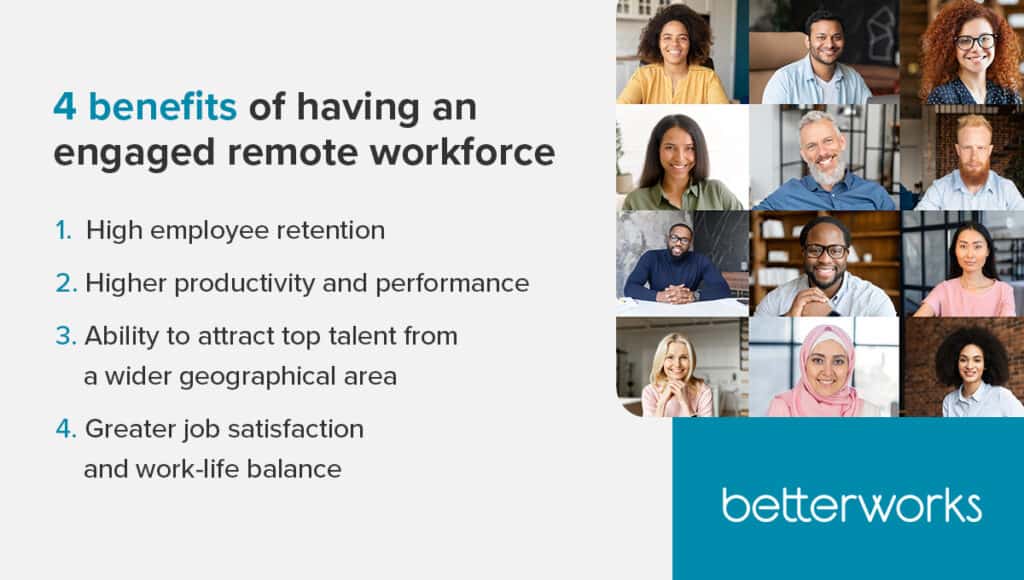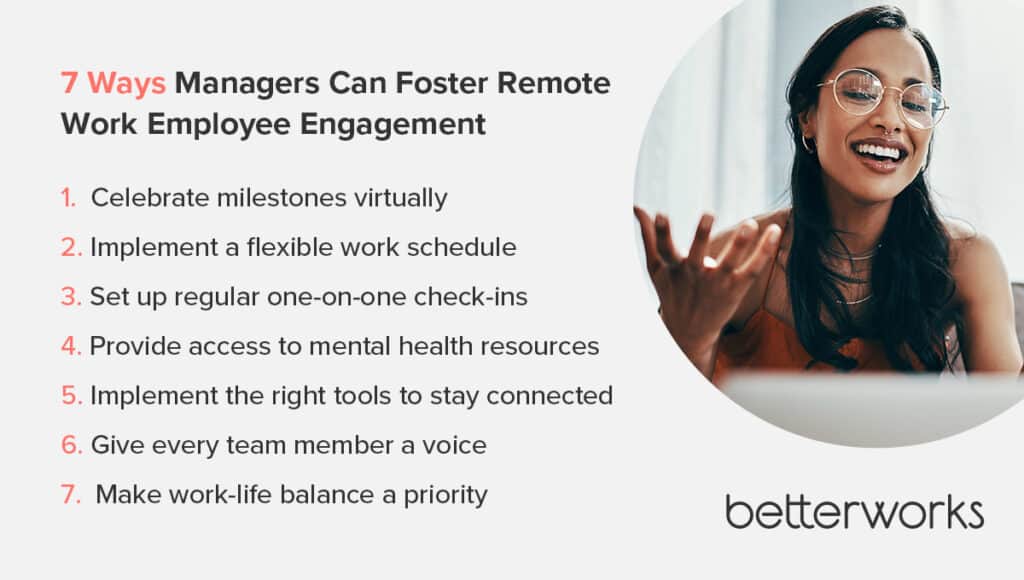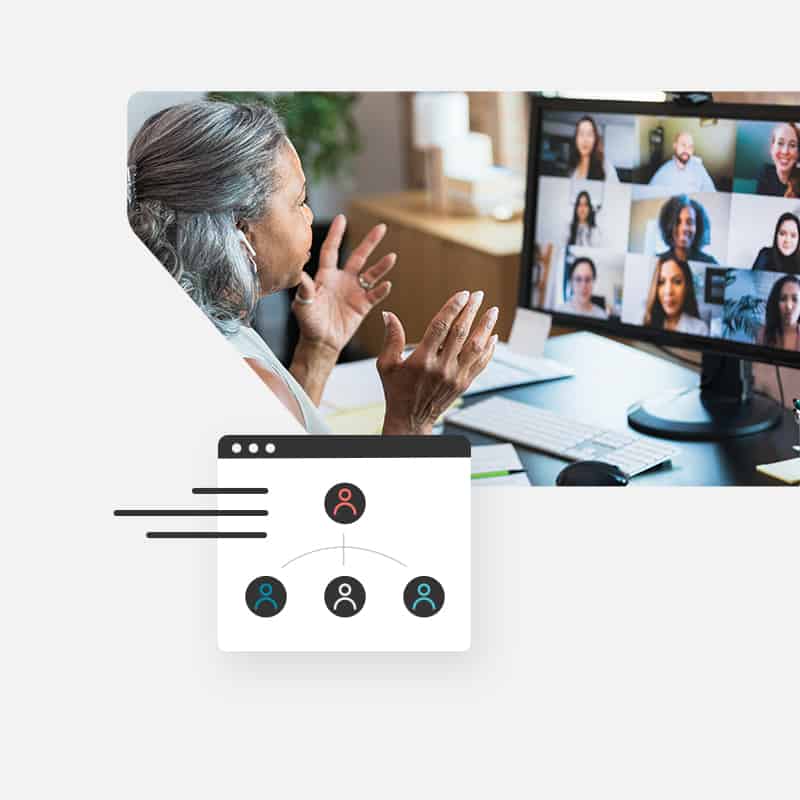- What makes employee engagement so important for remote teams?
- Managers’ role in fostering employee engagement during remote work
- 3 remote employee engagement challenges
- 4 benefits of having an engaged remote workforce
- 7 best practices for managers to foster remote work employee engagement
- Lead remote work engagement activities to strengthen remote culture
Your workforce will only reach its full potential when employees are excited about their work and invested in driving your mission. But in distributed work environments, fostering motivation and engagement is more complex than ever. You need an intentional remote work engagement strategy to help your managers connect team members with each other and the organization.
Don’t let companywide remote work be a barrier to engagement in your organization. Learn what remote work engagement is, why it matters, and how you can equip managers to foster it within your workforce.
What makes employee engagement so important for remote teams?
People logging in from home are at risk of feeling lonely or isolated within their jobs. They may not feel like they have a strong connection to the business, their co-workers, or their manager. But fostering employee engagement in remote teams can help supply the human connection that’s lacking in many remote work situations.
Employees who are engaged are more than just present at work: they’re enthusiastic about what they do and find fulfillment in their work. Shared engagement builds community, camaraderie, and teamwork in your workers — even if there are hundreds of miles between them.
Managers’ role in fostering employee engagement during remote work
Managers are the glue that holds a team together, especially in remote work settings. As team leaders, managers provide each employee with visibility into the rest of the team and the organization at large. Managers are the catalyst for connections between the team and stakeholders across the business.
Because managers play such a pivotal role in creating connections, you can build on that to improve employee engagement during remote work.
Engagement starts with a person’s connection to their work. Managers can facilitate this connection by giving workers a line of sight into how their efforts affect the business. Your goal alignment software can help illustrate this connection. Managers also provide employee recognition, which reinforces the value of each person’s work.
Connection with other people is important for engagement, too, and can motivate a remote workforce to put in a strong effort to support collective goals. Managers must create space for team members to get to know each other, such as through video chats, activities, or small talk.

3 remote employee engagement challenges
Driving engagement is challenging even in traditional office settings. It’s often more complex when team members are physically distant. Watch out for these challenges to remote work engagement, and discover ways to overcome them.
Communication barriers
If you aren’t intentional about developing communication norms, remote teams will struggle with miscommunication. That drags down employee engagement and results in people prioritizing different things. People feel less connected when they’re working at odds with their co-workers.
Communication challenges can also lead to misaligned expectations. If employees and managers don’t have a clear, shared definition of what good work looks like, for example, employees can feel discouraged when their best efforts are met with criticism. That’s another risk factor for disengagement.
Remote teams often have to rely on asynchronous communication to create a fair experience across time zones. That can add an extra layer of distance between individuals that can hinder engagement.
You can overcome communication barriers by training managers to communicate transparently and to seek clarification rather than assuming what someone is trying to say.
Lack of in-person interactions
The physical distance between team members can make it difficult to build relationships and trust, which are key to driving engagement. Employees who don’t feel connected to their team members will be less motivated to perform well for the sake of the team.
Employees working remotely are less likely to have spontaneous encounters, or “water cooler moments,” which makes it harder for team members to get to know each other outside formal meetings.
One remedy is to create simple employee engagement activities with managers as hosts. The occasional shared lunch date, for example, supports greater bonds between team members.
Decreased sense of belonging
Communication barriers and lack of in-person interactions can take a toll on a person’s sense of belonging. Without frequent communication and nonwork interactions, it’s more challenging for managers to build a sense of community.
Managers can develop community and belonging by actively engaging team members during meetings or assigning them to projects where they can work together. The safer employees feel about speaking up and being authentic with their co-workers, the more likely they are to engage with their work.

4 benefits of having an engaged remote workforce
Fostering remote work engagement supports several long-term benefits for your business.
High employee retention
One of the biggest advantages of engaging a remote workforce is that it can help you retain your best employees. Engaged employees are more invested in their work and the team. And when your employees feel valued and supported, they’re more likely to stick around — even if they have high earning potential elsewhere.
Higher productivity and performance
Engaged employees are more invested in their work and passionate about reaching their performance potential. An engaged remote workforce can perform at a higher level than a disengaged workforce, regardless of location.

Ability to attract top talent from a wider geographical area
With the increase in employees working remotely, companies are no longer limited to candidates who live near their offices. These employers enjoy a larger pool of potential candidates, which can lead to a higher quality of new hires.
Strong remote work engagement supports a healthier culture and happier employees, which are huge selling points for attracting top talent across the globe. A focus on engagement also helps during the crucial onboarding process for these remote hires.
Greater job satisfaction and work-life balance
Employees who work from home often have more control over their work environment, which can lead to better job satisfaction and work-life balance. Remote employees with high engagement are better able to regulate their workloads and find the right balance between their work and personal lives.

7 best practices for managers to foster remote work employee engagement
Implement these remote work engagement ideas to help team members find their passion within your organization.
Celebrate milestones virtually
Creating a sense of community is essential to engaging remote employees. Managers can facilitate community by encouraging employees to celebrate shared wins and milestones as a team.
On a monthly or quarterly basis, for example, bring team members together virtually to share kudos and celebrate team accomplishments. In addition to building community, it also helps team members understand how their work connects to everyone else’s.
Implement a flexible work schedule to allow for better work-life balance
One of the advantages of remote work is flexibility. Team members have more control over when, where, and how they work. That helps them get work done and address personal needs.
Workers with children, for instance, might need time to pick their kids up from school or take them to appointments during regular work hours. Giving these employees flexibility for such personal priorities will help your people take care of what’s important personally so they can focus on work when they’re logged on.
Set up regular one-on-one check-ins
One of the best ways to foster employee engagement is to set up one-on-one check-ins between managers and employees. These ongoing conversations give employees the chance to voice concerns or issues they’re having, and they also allow managers to coach and give and receive feedback.
When managers have teams that embrace remote work, coaching and feedback not only clarify performance expectations but also bridge gaps in knowledge or communication that employees experience because they’re not on-site.
Delivering remote coaching and feedback can be challenging. To get the most out of one-on-one check-ins, train managers to provide actionable, constructive insights and suggestions that employees can apply immediately to improve their performance. One way to help managers get started is to provide conversation prompts.
Provide access to mental health resources
Burnout is a major cause of disengagement, and remote work can amplify that problem. Employees need to know what resources are available to help them protect their mental health.
Educate managers on the resources included in your health and benefits plan, such as your employee assistance program. Provide managers with materials they can use to help employees understand how to make the most of these resources.
Implement the right tools to stay connected
Workforce technology vendors are regularly upgrading and evolving their products to support remote workforce collaboration and engagement. Review the tools available (including your tech stack’s capabilities) to determine what’s best for your workforce.
Whatever tech solutions you choose, you’ll need guidelines for how to use communication tools, such as video conferencing software or collaboration platforms. Other tools, such as project management or goal alignment software, can help remote workers stay engaged and connected. This way, they can see what others are doing within the business.
Give every team member a voice
Belonging is key to engagement, and that means that every team member must feel comfortable speaking up. Create an environment where people feel safe sharing their opinions, even if they differ from the majority. Be open to receiving feedback from employees, and follow through on any changes you promise.
To drive a culture of belonging, train managers to encourage engagement from each of their reports during group calls. A core responsibility of managers is fostering trust with their team members and soliciting (and listening to) their thoughts and ideas.
Make healthy work-life integration a priority
Employees need to know that you and their manager care about them. Although remote employees may not interact directly with HR very often, you can develop policies that signal the value you place on each person and their contributions.
Prioritizing healthy work-life integration sends a clear signal to employees that their well-being is important. Train managers to track and rebalance workloads to make sure that no one is overloaded. When people have to-do lists that are reasonable and realistic, they’re less likely to suffer from burnout.

Lead remote work engagement activities to strengthen remote culture
You can promote a positive, engaged company culture without making people come into the office. When you understand the challenges of remote work engagement, procure the right technology, and train your managers, you empower employees to find their passion inside your organization.
Check out our ultimate guide to remote workforce management to learn more.







